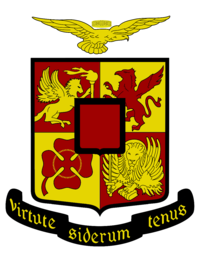Italian National Royal Air Force (Kingdom of Italy)
| Italian National Royal Air Force | |
|---|---|
| Regia Aeronautica Militare Nazionale Italiana | |
 Coat of Arms of the Italian National Royal Air Force | |
| Founded | 28 March 1923 as Regia Aeronautica |
| Country | Kingdom of Italy |
| Branch | Air force |
| Type | Air force |
| Role | Aerial warfare |
| Size |
50,000 personnel 850 aircraft |
| Part of | Italian Armed Forces |
| Motto | Virtute Siderum Tenus (English: With valor to the stars) |
| March | Marcia di Ordinanza dell'Aeronautica Militare (Ordinance March of the Air Force) by Alberto Di Miniello |
| Anniversaries | 28 March (Air Force Day) |
| Commanders | |
| Chief of Staff of Military Aviation | Lieutenant General with special duties Marco Fucani |
| Insignia | |
| Roundel |
 |
The Italian National Royal Air Force (Italian: Regia Aeronautica Militare Nazionale Italiana; R.A.M.N.I.) is the Air force of the Kingdom of Italy. The Italian Air Force was founded as an independent service arm on 28 March 1923, by King Victor Emmanuel III as the Regia Aeronautica (which equates to "Royal Air Force"). When Italy was made a Republic by Benito Mussolini, the Regia Aeronautica was given the name of National Republican Air Force. Since 2002 the Air Force was given the current name. Since its formation the service has held a prominent role in modern Italian military history. The aerobatic display team is the Frecce Tricolori.
Air Brigade
The air brigade is a large military unit, which involves the interaction and control of two or more Storms, which hierarchically depend on it, and responds to the command of a pilot air brigade general. Air Brigades include:
- a command;
- at least two Storms (or corresponding departments);
- Groups and Services responsible for operational support and direct logistics.
In the Italian Army the air brigade uses the Cavalry titles. At the moment the Air Force deploys three Air Brigades and the Italian Army deploys an Air Brigade:
- 1st Aviation Brigade for Special Operations, located at the Francesco Baracca di Centocelle airport in Rome;
- 2nd ISTAR-EW Air Brigade, at the Pratica di Mare Airport (Rome);
- 3rd Air Brigade, at the airport of Pisa-San Giusto;
- Army Aviation Brigade, at the Viterbo airport.
Wing
The Wing (Italian: Stormo) is an air unit of an air force based on an airport and, consequently, is the main subdivision of the peripheral operational organization of this armed force. As a rule, the Wing is divided into Flight Groups, and includes in itself all the supporting logistic units necessary for the operations of an air base. The Wing is controlled by a pilot colonel. The Wing is equated with the ground forces Regiment. In the Italian Air Force a Wing is normally made up of:
- a Command;
- two or more Flight Groups;
- an Aircraft Efficiency Group
- a Squadron Links / Connections and Rescue
- Groups or Services of Operational Support or Logistic Direct.
The General Staff of the Air Force may decide to give the name of a flock also to Organizations and elements of organization with combat units (such as Air Riflemen), which however do not have piloted or remote controlled air vehicles, or organisms whose main activity is aimed at operational support in operations.
Flight Group
The Flight Group (Italian: Gruppo di Volo) is an air unit of the air force. This unit operates within a Wing, defining itself as the second subdivision of the peripheral operational organization. As a rule, the Flight Group does not include all the logistic support units necessary for the operations, relying in this to the Wing structure. The Flight Group is equivalent to the battalion for ground forces, it is usually commanded by a pilot lieutenant colonel and is normally made up of:
- a Command;
- two or four Flight Squadrons.
Flight Squadron
A Flight Squadron (Italian: Squadriglia di Volo) is the fundamental organic unit, usually commanded by a captain and composed of a variable number of identical planes, depending on the specialty. A Flight Squadron is made up of three Sections, the latter being under the command of a lieutenant or a second lieutenant; a fighter section is normally composed of 4 planes, a bombardment section or a observation section consists of 3 planes.
